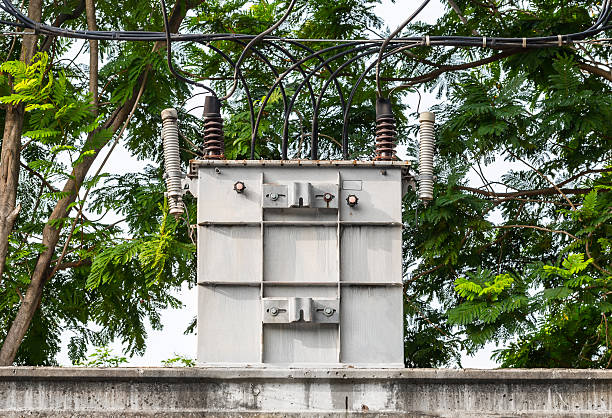What does a wiring transformer mean?
A transformer type intended especially for wiring purposes inside electrical systems is sometimes referred to as a wiring transformer . These transformers can adjust voltage levels to meet the needs of various electrical components or devices in a wired system by stepping them up or down as necessary. A wire transformer’s main job is to convert voltage levels to the right levels for certain applications, enabling the safe and effective transfer of electrical power. This is especially crucial in cases when certain devices or components demand a different voltage from the one provided by the power source or electrical grid.
Knowing the Fundamentals of Transformers:
Before we begin the wiring procedure, let’s review some basic wiring transformer knowledge:
Functions: Transformers change the voltage level to transmit electrical energy from one circuit to another. The input voltage is received by the main winding, whiles a different voltage, either greater or lower, and is produced by the secondary winding.
Types: Distribution transformers (which scale down voltage for local distribution), isolation transformers (which offer electrical isolation for safety), and power transformers (used in high voltage transmission) are common types.
Specifications: Important factors to take into account are the voltage input/output, single- or three-phase transformer type, and KVA rating, which measures the transformer’s capability.

Safety First: Crucial Safety Measures:
The following safety precautions should always come first during the hiring process:
Work with de-energized equipment at all times: Before doing any repair, turn off the power source and check with a voltage tester.
Double-check your connections: Using your torque wrench, make sure each connection is firmly fastened and torqued to the correct level.
Grounding is crucial: Safe functioning and protection against electrical shock are guaranteed by proper grounding.
How to Wire a Single-Phase Transformer? A Comprehensive Guide
Assemble your supplies and tools for preparation. Make sure the transformer is turned off and use a voltage meter to confirm.
Determine Terminals: Identify the transformer’s primary and secondary winding terminals, which are usually denoted by the letters “H” for primary and “X” for secondary.
Cut and Strip cables: Using your installation pattern as a guide, cut your cables to the proper length. Depending on the wire gauge, remove the insulation from each end of the wire.
Connect Primary Winding: Attach the relevant wires to the primary terminals by following the wiring diagram and manufacturer’s instructions. Using your torque wrench, firmly tighten the connections to the specified torque.
Connect Secondary Winding: To connect the secondary winding, repeat step 4 and make sure the terminals are securely torqued and properly connected. If a terminal block is being used, attach the secondary wires to it in the order that the intended output is to be configured .
Grounding: Attach the grounding wire to the transformer’s specified grounding lug.
Verify again and be safe: Check again that all connections are made securely and under the wiring schematic. Enclose any exposed wire in conduits that have been authorized.
How can you choose the wiring transformer that best suits your needs?
To ensure compatibility and maximum performance, choosing the best wiring transformer for your needs requires taking into account several important aspects. Here’s a detailed how-to:
Determine Voltage Requirements: Analyze your application’s voltage needs, taking into account the input voltage (the voltage at the power source) and the output voltage (the voltage required for your equipment). Verify that the input voltage can be converted by the transformer to the intended output voltage.
Determine electricity Requirements: Determine how much electricity your device needs in watts or VA (volt-amperes). To calculate the power usage, multiply the voltage by the current (measured in amps). Select a transformer that can easily manage the needed power demand .
Think About Frequency Compatibility: Make sure the transformer can operate at the same frequency as the equipment and the power supply. Although some transformers may work with both frequencies, the majority are made for either 50Hz or 60Hz frequencies.
How to Choose a Transformer Type:
Transformers, reactors, and filters, among other conventional and bespoke electromagnetic components, are among the many applications for our products. As an integrated provider of R&D, manufacturing, and sales, we have a long history. We uphold the highest standards for quality, speed of service, and cutting-edge technology. Choose the transformer type that best suits the needs of your particular application. Typical kinds include:
Step-Up Transformers: Boost the output voltage by increasing the input voltage.
Step-Down Transformers : Reduce the voltage from the input to the output using step-down transformers.
Isolation transformers: These devices reduce noise and increase safety by providing electrical isolation between the input and output circuits.
Auto-transformers: To provide varied output voltages, they have a single winding with many taps.
The following are typical uses for wire transformers:
Voltage Conversion: To reduce the voltage levels from greater distribution voltages to lower voltages appropriate for industrial, commercial, or residential uses, wiring transformers are frequently utilized.
Isolation: Electrical isolation between various wire system components is possible using wiring transformers, which help shield delicate equipment from noise, voltage surges, and other electrical disruptions.
Distribution: To ensure effective and dependable power distribution, wiring transformers can be employed in distribution networks to deliver electricity to several circuits or devices at various voltage levels.
Control and Instrumentation: To supply the required voltage levels for sensors, relays, and other control devices, wiring transformers are also often utilized in control and instrumentation circuits.
Conclusion:
The wiring transformer from Shinenergy is widely used in a wide range of high-demand power electronic systems. This transformer is well-known for its stability and dependability. It runs with little loss and little noise, which makes it the perfect option for these crucial applications. Its construction guarantees long-term durability and effective operation even in the harsh environments typical of these cutting-edge power systems. With our R&D team, we can create in accordance with the needs of the customer

